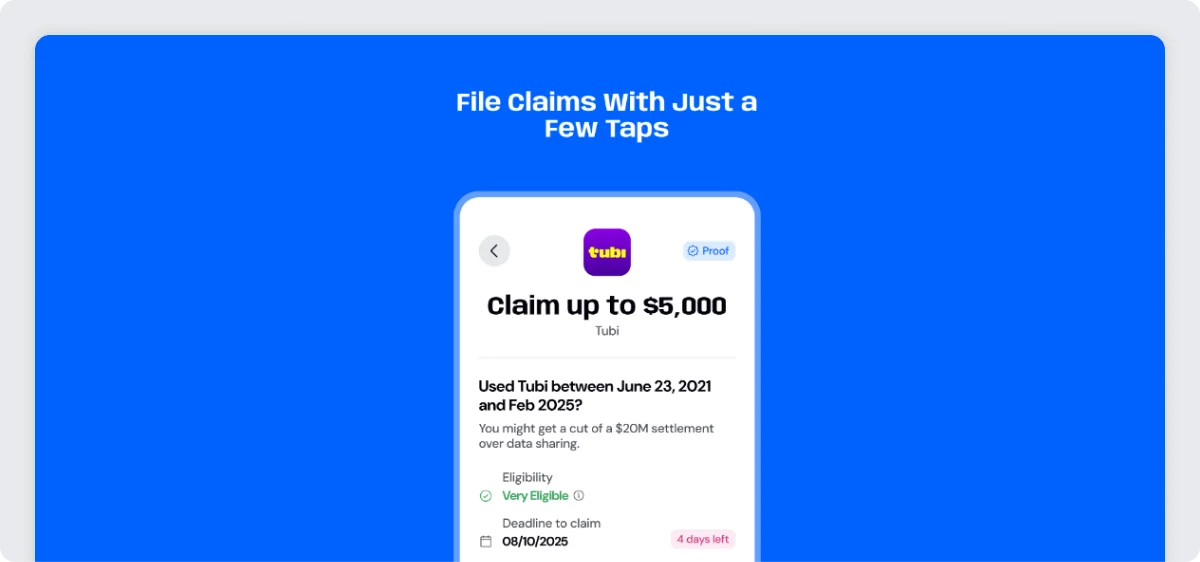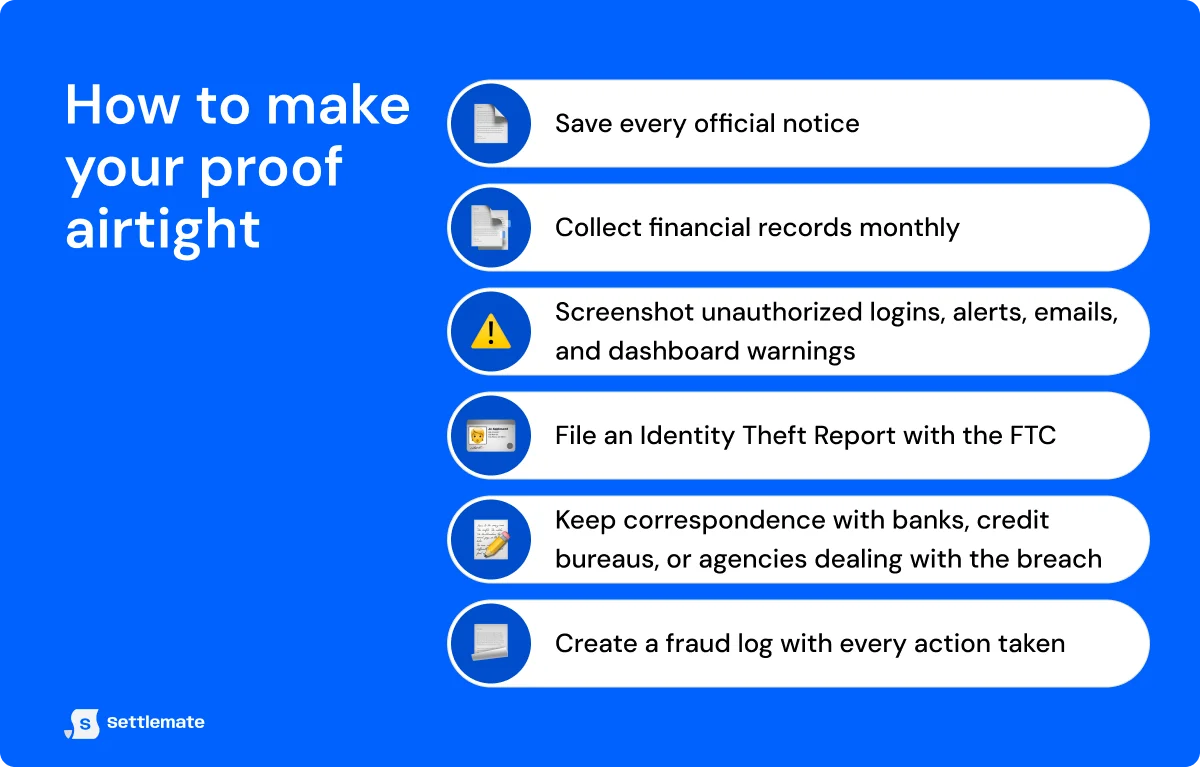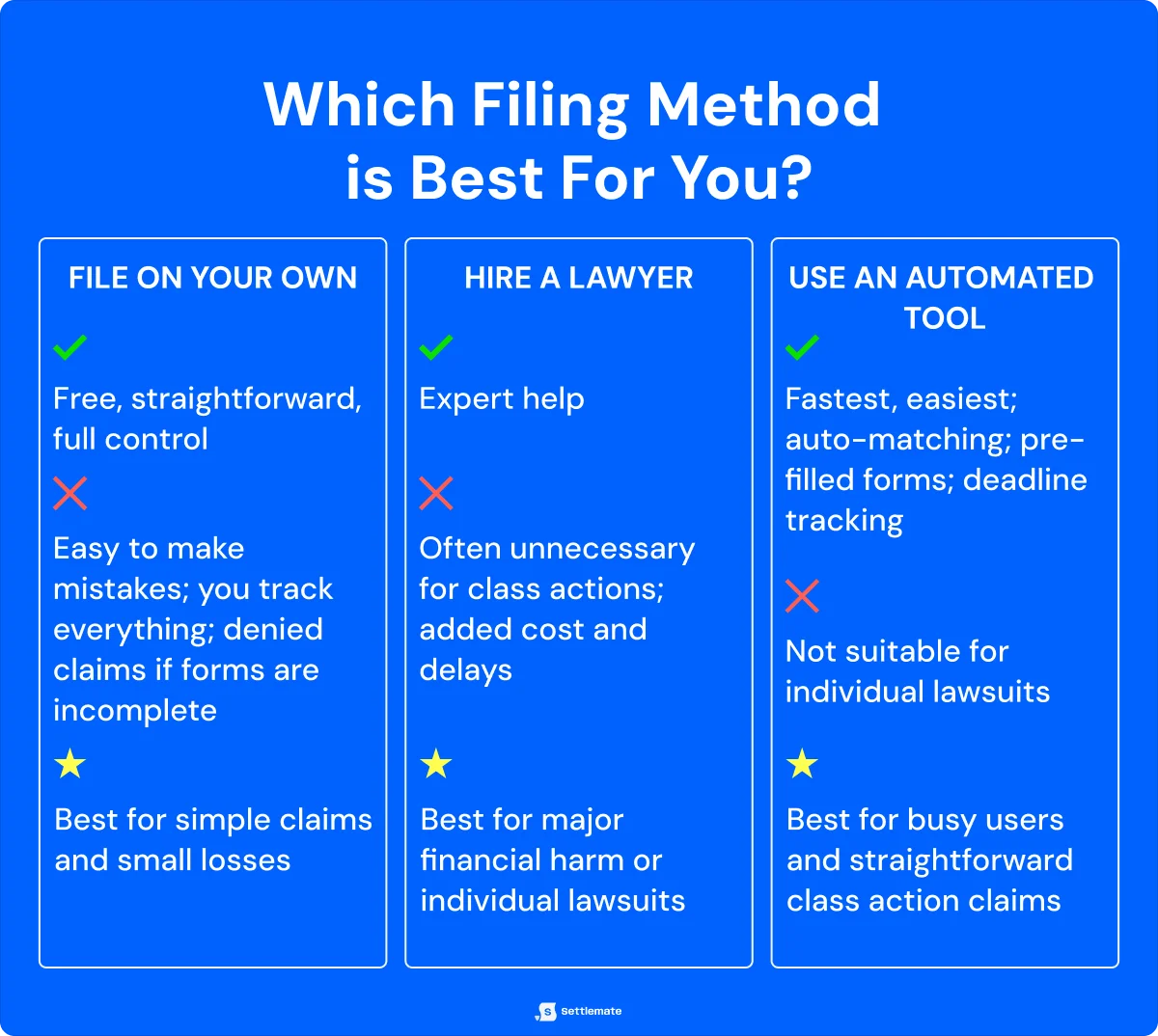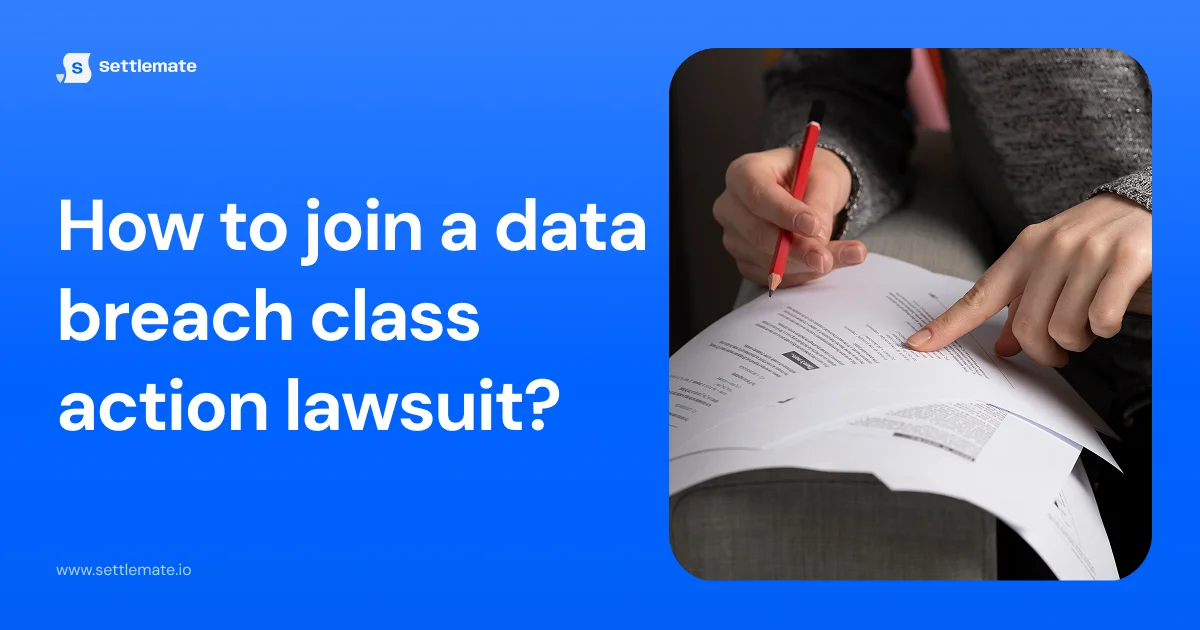When giants like T-Mobile, Cash App, and Ticketmaster get hit with data breaches—and they do, over and over—what chance does an average consumer have? If the companies with billion-dollar security budgets can’t keep your information locked down, your data is basically free-range at this point.
And the numbers seem to agree.
In 2024, the U.S. logged 3,205 breaches—roughly nine a day. The 2025 figures? Already pacing to beat that.
Here’s an upside to an otherwise messy situation: you’re not dealing with this alone. Every major breach sets off a chain reaction of class actions and settlement funds.
And that’s precisely what this guide will teach you: how to join a data breach class action lawsuit without jumping through hoops.
Key takeaways
- You must confirm that you were actually part of the breach
Before you can file anything, you need to verify that your information was exposed. You can do this through official breach notices, public databases, or automated tools. Without confirmation, you won’t qualify for a class action. - Eligibility depends on meeting strict legal requirements
Courts limit class membership to people who can show they were part of the breach, suffered harm (or a recognized risk), and can reasonably link that harm to the incident. - Documenting harm is essential for getting paid
Unauthorized charges, tax issues, credit inquiries, breach notifications, and even time spent fixing the damage all strengthen your claim. The more complete your documentation, the easier it is to qualify and maximize your payout. - You can file on your own, hire a lawyer, or automate the entire process
DIY filing works for simple cases. Lawyers are best for major individual losses. Automated tools are ideal for most class actions because they remove the tedious work: forms, deadlines, and evidence management. - The easiest path is using a tool that finds and files claims for you
Most people miss compensation because they never receive notices or don’t realize a lawsuit exists. Settlemate fixes that. It monitors active lawsuits, identifies the claims you qualify for, prepares your filing, tracks deadlines, and organizes every step for you.
How to find out if you were affected by a data breach: 3 ways to check
Before you think about filing a claim, you need one crucial piece of information: were you actually affected? Here are three ways to find out.
1. Official breach notifications
Sometimes, confirming you’re part of a data breach is as simple as opening an email starting with something like: “We’re writing to inform you of a recent security incident.”
That’s because companies are usually legally required to notify you when your personal data is exposed.
Every state has its own breach-notification laws, and most require direct communication—usually by email or physical mail—when sensitive information like Social Security numbers (SSNs), bank details, or medical data are compromised.
But a notice alone doesn’t guarantee legitimacy. Scammers send fake breach emails all the time, hoping you’ll click on a malicious link or “verify” your information.
Remember: a real notice explains what happened; it doesn’t ask for personal data.
When in doubt, confirm the breach through the company’s official website or by checking with a data breach lawyer.
2. Public databases
Unfortunately, it’s possible to miss an official breach notice. Spam filters, outdated email addresses, full inboxes… it happens.
That’s why you should keep an eye on the publicly available breach disclosures. This is also a great way to double-check a breach after receiving a suspicious notice.
To do so, look at the same sources lawyers use:
- State attorney general websites
- Consumer protection agencies
- Official corporate press releases
These databases confirm whether a breach happened, when it happened, and what type of data was exposed.
The downside?
They’re spread across dozens of sites, updated inconsistently, and usually not designed for everyday consumers.
3. Automated detection tools
If you want the simplest, fastest way to know whether you were affected by a data breach, use an automated tool that checks this for you.
These tools scan the same breach feeds that lawyers and regulators monitor, cross-check them with your information, and alert you if your data appears in a known incident.
No digging. No spam hunting. No legal guesswork.
However, not all incidents immediately lead to data breach litigation.
Some take months before lawyers file, the courts approve the class, or the claim forms go live. So, if you don’t want to track headlines, you can use an automation tool that only alerts you when a class action actually exists.
Apps like Settlemate focus on that exact moment.
Settlemate can automatically match you to active lawsuits and settlements, showing you only the claims you’re likely eligible for and saving you hours of research.

How to evaluate whether you have a valid claim
Joining a class action lawsuit isn’t as simple as hearing about a breach and signing up. You actually have to qualify and prove you were impacted.
Here’s what that entails.
Understanding your legal standing
A breach alone doesn’t guarantee you qualify for a class action suit; the court sets specific rules for who’s in the class.
So, before you file anything, you need to understand whether you legally fit the definition of a class member and whether the law recognizes you as someone who can claim compensation.
Below is a quick breakdown of what makes you eligible to join a data breach class action lawsuit.
Documenting evidence of harm
Courts won’t approve compensation unless there are actual losses or a credible risk tied directly to the breach. But keep in mind that the latter route isn’t a free pass.
In data breach cases, this is one of the most heavily contested issues, as courts tend to push back on claims based solely on “future harm” unless the stolen data makes identity theft genuinely likely.
In most cases, your claim will lose strength fast if you can’t demonstrate injury. This can even lead you to be excluded from the class altogether.
The good news?
Most people have more evidence than they realize. You just need to collect it, organize it, and keep it accessible.
Here’s what to focus on:
- Financial records – bank and credit card statements showing unauthorized charges, unusual activity, or any transactions you had to dispute or reverse
- Identity theft indicators – signs your information is being misused, such as rejected tax returns, surprise credit inquiries, fraudulent accounts, or collection notices for debts that aren’t yours
- Official documents – anything that confirms the breach or resulting fraud, including breach notification letters, FTC Identity Theft Reports, police reports, or notices from banks or credit bureaus
- Proof of expenses or lost time – receipts, invoices, and logs showing credit monitoring costs, time off work, freezing or unfreezing credit, or any cleanup-related expenses

How to join a data breach class action lawsuit in 2 steps
After gathering your information and evidence, there’s only one thing left to do: join the class action tied to your breach.
Here’s how.
Step 1: Decide how you want to file
There’s more than one way to join a data breach class action lawsuit.
You can do it yourself, hire a lawyer, or use an automated tool that handles the process for you. Each option works, but they’re not equally simple or equally suited for every situation.
Filing the claim on your own
Filing the claim on your own is the most hands-on approach.
You go straight to the settlement website, fill out the required forms, upload your proof, and submit everything before the deadline. This option makes sense if your losses are small or easy to document.
However, choosing this option also means being fully responsible for every detail. Make a mistake or miss a document, and your claim can be denied.
Hiring a lawyer
If you aren’t ready for the responsibility that comes with filing a claim, you can hire a lawyer to do it for you. But keep in mind that this move makes more sense in private, individual data breach lawsuits.
These lawsuits are reserved for individuals who suffered major financial harm, identity theft, or long-term damage and can prove the fallout happened as a result of the breach.
For class actions, hiring a lawyer might be overkill.
Why?
Because the class already has legal representation, and the payout structure is the same whether you hire your own lawyer or not. In other words, hiring a lawyer for a simple class action claim only adds cost and complexity without increasing payout.
Using an automated tool
This option combines the best parts of DIY convenience and lawyer guidance without the cost or the paperwork headache.
Automated platforms help you file the claim correctly, on time, and with the right documentation. They remove the friction that causes many people to miss out on a payout.
Settlemate will prepare the claim for you and submit it on your behalf. It will also monitor filing windows and alert you before you miss anything important.
You will still have full control of the filing process, but the app takes care of the complicated and time-consuming parts.

Step 2: Submit your claim
The table below summarizes what filing the claim looks like based on your chosen method:
Why Settlemate is the easiest way to claim what you’re owed
If you’ve been wondering how to join a data breach class action lawsuit, the truth is that the process is relatively simple, as long as you know where you stand and which steps to take.
While you can file on your own or hire a lawyer, the most straightforward, cost-efficient option is using an automated tool that handles the heavy lifting for you.
But here’s the real advantage: automated tools don’t just help you file after you get a notice. They help you spot the opportunities, so you know there’s a class action you should be a part of, even if you’ve never received an alert.
That’s another reason you need Settlemate.
It constantly scans active lawsuits, newly approved settlements, and official disclosures to help you uncover and claim compensation you might otherwise miss.
Settlemate helps you:
- Spot eligible claims early by monitoring newly filed lawsuits and settlement announcements the moment they go live
- Avoid missed payouts with real-time alerts for claims tied to companies you’ve interacted with
- Cut through legal clutter by showing only the settlements that actually apply to you
- Stay organized by keeping all your claim confirmations, timelines, and next steps in one place
- Protect your privacy with secure data handling designed for sensitive information
You deserve compensation for the data breaches that put your information at risk, but you shouldn’t have to chase it. Let Settlemate do the work.
Download the app on App Store or Google Play and start claiming what you’re owed today.

FAQ
How do I get compensation for a data breach?
You can receive compensation through an individual lawsuit or a data breach class action settlement. If you were affected, you can submit a claim through the official settlement website, a lawyer, or an automated tool like Settlemate.
How do I join a data breach class action lawsuit?
To join, you simply submit the claim form for the specific settlement. If your data was part of the breach and you meet the class definition, you’re automatically eligible—no need to appear in court or hire a lawyer.
How much can you get from a data breach settlement?
Amounts vary widely depending on factors like the scale of the breach, the sensitivity of exposed data, and the number of claimants. Noteworthy examples range from $50 per class member in a LinkedIn class action to up to $10,000 in a Target settlement.









